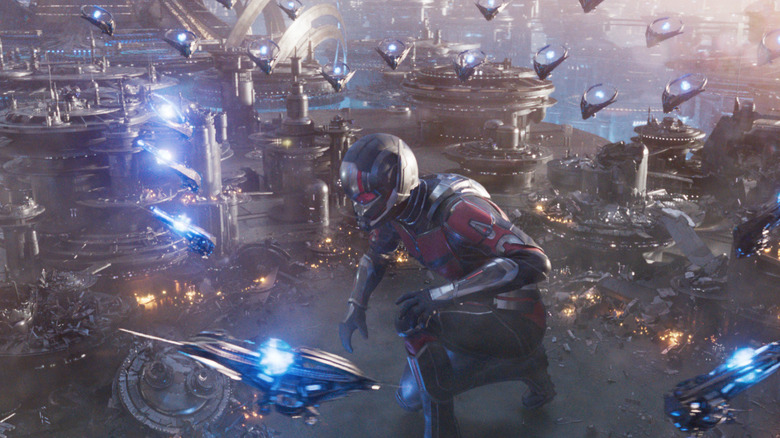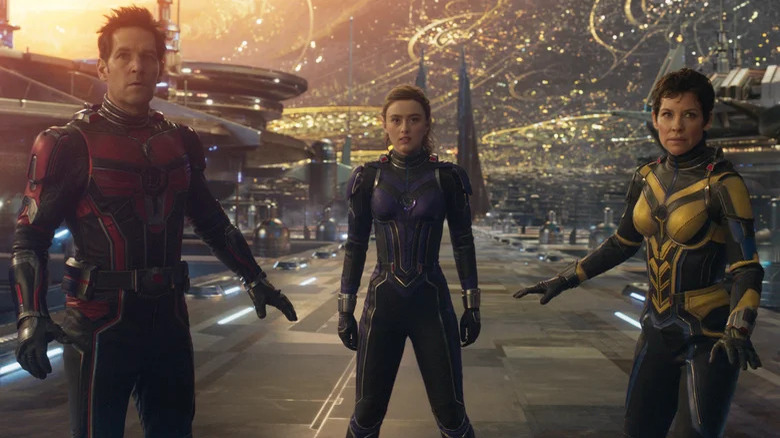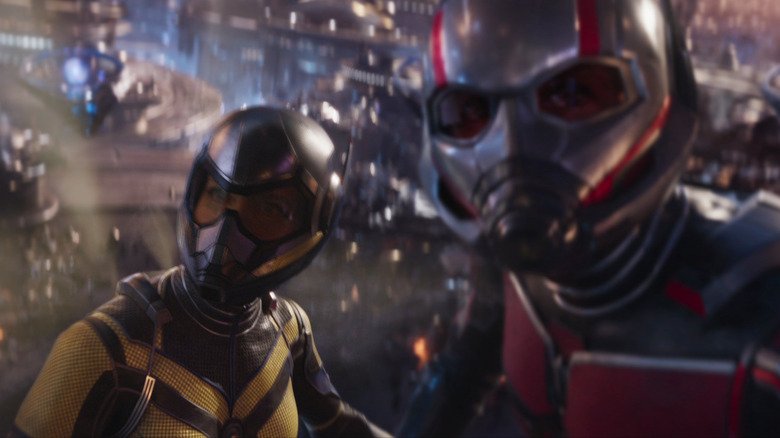Peyton Reed Worried The Mandalorian's Volume Tech Wasn't 'Ready' For Ant-Man's Quantum Realm
The virtual vistas and stunning micro-world on display in "Ant-Man and the Wasp: Quantumania" transport audiences into the Quantum Realm in spectacular fashion. To help bring all of those mind-blowing, truly weird landscapes to life, director Peyton Reed turned to the same state of the art technology used by "The Mandalorian." Reed had previously directed two episodes of "The Mandalorian," including the season 2 finale, so he had already familiarized himself with the volume technology used to create believable backdrops in real time.
Also referred to as StageCraft, the Volume places massive LED panel walls behind actors that project photo-real backdrops as a replacement for an actual, physical location. Luckily for Pedro Pascal and the other performers on the hit Disney+ series, they never have to worry about cleaning sand out of their suits or acting under the hot sun of the Tunisian desert. The planet of Tatooine can now be recreated in the comfort of a closed set.
Reed saw firsthand how the Volume technology worked and how it could possibly be applied to the outlandish universe within the Marvel Cinematic Multiverse known as the Quantum Realm. There was only one problem. The locations within the "Star Wars" universe are much more familiar and recognizable than the fantastically strange world explored in "Quantumania." Understandably, Reed was a tad skeptical, telling Collider, "There were things that I wanted to do, but I wasn't sure that the volume technology was ready for it." It turned out that, in some cases, the vastness of the microscopic Quantum Realm was actually too big to fit inside the Volume altogether.
Making the impossible real
The bizarre creatures and immeasurable cityscapes featured inside the world of "Quantumania" are hallucinatory and undeniably weird, almost to the point where it's too much of a good thing. Without the use of the Volume, the realism of the Quantum Realm could have been significantly compromised, even though the technology wasn't always the perfect fit for what Peyton Reed wanted to accomplish. The director told Collider:
"We ended up using the volume technology, it was great for certain environments, but not necessarily right for other ones. There's also just size and shape. Sometimes our sets are too big for the volume, so we would use partial sets."
The Volume was still a great asset to help bring the Quantum Realm to life, mainly because of how grounded the actors felt. "It was definitely one of the tools we used in our toolkit, and the actors love it because they get to see a version of what they're [going to] see in the movie," Reed said. "The interactive lighting is obviously great, but it's great, the actors love it. It's not always the right tool, but I liked it because we wanted to create all these different parts of the Quantum Realm that had to look and feel differently."
The world building that's required for something akin to the Quantum Realm makes the locations of "The Mandalorian" seem much more intimate in comparison. It's an invaluable new tool, but Reed recognizes that it's not necessarily going to be a total game-changer in the future.
Pushing the latest technology to the limit
Ideally, the volume technology would be able to facilitate the needs of filmmakers whether they're creating a television series or a massive Marvel movie that has to connect to 15 years of comic book mythology. The LED technology and the interactive, interchangeable lighting absolutely helped to make the Quantum Realm seem like a real place that had sunrises and sunsets, even if the passage of time functions differently than the world up on top.
For audiences to suspend their disbelief, the Volume tricks our eyes enough that we buy that what we're seeing is an actual place. Still, Peyton Reed recognizes there are some things the volume tech can't do, and that films like "Ant Man and the Wasp: Quantumania" are needed to continue to push the envelope:
"There are limitations to it, and we push that system to its limit on this movie. There are things that it could do and it can't do. What works so well in 'Mandalorian' is they have a lot of lead time, because they're doing a whole series, to invest and create these environments, and on the schedule we were on, it's not always right for that situation."
The living green screen of the Volume will continue to be an essential part of bringing a myriad of Disney properties to life. For now, though, it seems better suited for the world of television. In addition to the immersive virtual environments created for "Quantumania," there were also new innovations like 3D VR location scouting, another tool that is potentially game-changing. "Ant Man and the Wasp: Quantumania" may be a little too convoluted and eye-popping for its own good, but it is testing the boundaries of what's possible.


